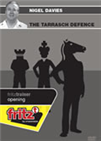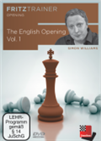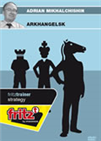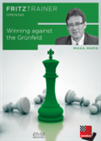The Gashimov Memorial endgame
The first complete game of the eighth day was that of Teimour Radjabov and Sergey Karjakin. Both players followed — deliberately or unconsciously — in the Reynolds attack (11.d5) of the Meran variation in the semi-Slav, through the 21st move of a game from 2012.
 For Shirov the Slav and the Semi-Slav form one huge and common opening. Of course it is a mighty opening complex and the DVD cannot give a complete picture of it, but in the areas he chooses to highlight our author is an absolute expert and capable of giving the deepest possible insights into the secrets of this extremely solid opening.
For Shirov the Slav and the Semi-Slav form one huge and common opening. Of course it is a mighty opening complex and the DVD cannot give a complete picture of it, but in the areas he chooses to highlight our author is an absolute expert and capable of giving the deepest possible insights into the secrets of this extremely solid opening.
Karjakin was the first to deviate away from the predecessor with 21...g6. The pieces were gradually exchanged off until a drawish rook ending which was settled on move 40.
In the game between Ding Liren and the draw king of the tournament Rauf Mamedov, the Tarrasch variation of the Queen's Gambit was on the board. Here in the main line with 9.Bg5, then 9...c4 is the second most common move, after which Ne5 is the usual reply.
 (1.d4 d5 2.c4 e6 3.Nc3 c5) is an excellent choice for Black, especially for players at club level. Offering Black the kind of free piece play that is missing from other defences, it was a great favourite of World Champions Boris Spassky and Garry Kasparov, not to mention its originator Dr. Siegbert Tarrasch. Amongst the many advantages of the Tarrasch is the fact that it can be used against the English and Reti Openings.
(1.d4 d5 2.c4 e6 3.Nc3 c5) is an excellent choice for Black, especially for players at club level. Offering Black the kind of free piece play that is missing from other defences, it was a great favourite of World Champions Boris Spassky and Garry Kasparov, not to mention its originator Dr. Siegbert Tarrasch. Amongst the many advantages of the Tarrasch is the fact that it can be used against the English and Reti Openings.
The Chinese grandmaster, however, bypassed the main line, opting instead for the modest 10.e3. The game eventually culminated in a double-rook ending, in which White had the initiative but the position was objectively balanced. However, Mamedov let the game go with one fatal mistake:
Black is in check.m and has only two squares for his king. After 37...Kf6 everything is a-OK for Black. However, Mamedyarov's 37...Kh6, which he played almost instantly, loses on the spot to 38.Kg3, followed by 39.h4 threatened a very ugly mate.
This made Ding the first player to beat Mamedov in this tournament. And with plus two, he advanced to second place in the standings. What's more, he is now number five in the live world rankings, and within two Elo points of Vladimir Kramnik above.

Ding Liren hasn't lost a game since August, 2017! | Photo: Shamkirchess.az
Anish Giri has opened previous games against Magnus Carlsen with both 1.e4 or 1.d4. Today he tried 1.c4. Carlsen replied with 1...e5 and soon a Sicilian defence with reversed colours stood on the board. The players were "in book" until the 16th move, following a game between Levon Aronian and Ian Nepomniachtchi from the Grand Prix in Geneva last year which would have been known to both players.
 Williams main teaching method behind this set of two DVDs is to teach you some simple yet effective set ups, without the need to rely on memorising numerous complicated variations.
Williams main teaching method behind this set of two DVDs is to teach you some simple yet effective set ups, without the need to rely on memorising numerous complicated variations.
In the press conference, the world champion gave the impression that he considers the position from a black point of view already better. Carlsen quickly developed an attack against Giri's king.
Giri could not withstand Black's pressure, however much he tried. After the 43rd move he gave up.
There had been a little verbal brawl between Carlsen and Giri on Twitter during the Candidates Tournament. The Dutchman had teased Carlsen a bit and Carlsen had barked several taunts of his own. One could imagine that the world champion might have been particularly motivated against Giri, but in the press conference, there was no hint of animosity. On the contrary, the two young players were very friendly and collegial with each other.
The theme of the match between Veselin Topalov and Radoslaw Wojtaszek was the Spanish Arkhangelsk variation. Topalov avoided any deeper theoretical discussion and entered new territory with 11.a4.
 The Ruy Lopez represents one of the oldest and best openings for the first player, and everyone going for the Spanish game with Black faces the question of how he wants to tackle the white ideas. One of the more aggressive fighting methods is the move order 1.e4 e5 2.Nf3 Nc6 3.Bb5 a6 4.Ba4 Nf6 5.0–0 b5 6.Bb3 Bb7, which was developed in the early sixties by players from the north Russian town of Archangelsk and has carried this name ever since.
The Ruy Lopez represents one of the oldest and best openings for the first player, and everyone going for the Spanish game with Black faces the question of how he wants to tackle the white ideas. One of the more aggressive fighting methods is the move order 1.e4 e5 2.Nf3 Nc6 3.Bb5 a6 4.Ba4 Nf6 5.0–0 b5 6.Bb3 Bb7, which was developed in the early sixties by players from the north Russian town of Archangelsk and has carried this name ever since.
In the further course of the game, the Polish grandmaster then gained a foothold in the centre, and was gradually able to increase his advantage. By the time his rook landed on the second rank, Topalov was already in big trouble.
Finally, in the 34th move, Topalov gave up in the face of an inevitable mate.

David Navara, Shakhriyar Mamedyarov
Shakhriyar Mamedyarov tackled David Navara's Grunfeld defence with an early h4, just as he had played in several other games against the opening. Navara followed a line that Vachier-Lagrave had played twice against Mamedyarov five years ago but then deviated with 8.0-0. Mamedyarov's bold 10.d6 was a new and fresh idea.
 The Grünfeld is a highly dynamic opening in which Black's position often seems to hang together by a single thread; and yet, this apparently precarious equilibrium appears to be enough to make it entirely viable — up to the highest level.
The Grünfeld is a highly dynamic opening in which Black's position often seems to hang together by a single thread; and yet, this apparently precarious equilibrium appears to be enough to make it entirely viable — up to the highest level.
The game heated up very quickly and Mamedyarov came out of the resulting tactical complications with a material advantage in the endgame.
One last trick: in the case of 42.Kd3? the black pawn runs through. But 'Shakh' avoided that trap, played 42.Kf3, and Navara gave up.
Standings after eight rounds
Games of round eight
Translation from German: Macauley Peterson
Links
























